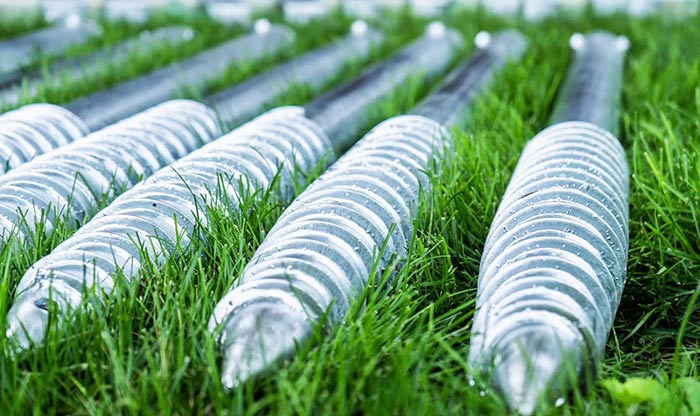When it comes to selecting the best foundation for solar panels, project developers and engineers face a critical decision: ground screws vs. concrete foundations. As the demand for faster, more sustainable, and cost-effective solar installations continues to rise, galvanized steel ground screws have emerged as a highly economical and environmentally friendly solution—especially for ground-mounted solar systems.
Helical screw piles, also known as spiral ground screw piles, are steel anchors with helical (spiral-shaped) plates welded along the shaft. They are driven into the ground without the need for excavation, making them ideal for quick installations in various soil types.
These ground screws are especially well-suited for solar racking systems, offering not only structural stability but also long-term durability and reusability.

In terms of mechanical performance, the reliability of helical screw piles for solar racking is determined by the blade spacing ratio (S/D, or spacing-to-diameter ratio). Research suggests that an optimal ratio of S/D = 3 to 4 delivers the best pullout and compressive load capacity. For smaller piles commonly used in solar applications, S/D = 3 is ideal.
Additionally, double-blade ground screws exhibit significantly stronger bearing capacities than continuous-blade designs, showing a near-linear increase in load support as blade diameter increases. For most ground-mounted solar projects, this makes double-blade ground screws the more efficient choice—both structurally and during installation.
One of the reasons galvanized steel ground screws are considered the best foundation for solar panels is their adaptability across different terrains and soil conditions. Unlike concrete foundations, spiral ground screws can be installed without heavy excavation and are less prone to deformation or cracking due to the high-strength steel used in their construction.
Solar racking systems generally impose moderate loads on the ground foundation. The inherent strength and integrity of ground screws ensure that these loads are easily absorbed without compromising stability—eliminating the need for oversized foundations.

A major concern with any metal foundation structure is corrosion. To combat this, galvanized steel ground screws undergo a thorough anti-corrosion process—primarily hot-dip galvanization after pickling and surface treatment.
The durability of the ground screw pile depends largely on this galvanizing process. Key factors affecting its effectiveness include:
Quality of welding and pipe materials
Surface treatment before galvanizing
Galvanizing time and temperature control
Absence of flaws such as sand holes or weak welds
With proper processing and care, galvanized helical ground screws can achieve a service life of 40–80 years. However, improper handling—such as damaging the protective galvanized layer during use—can accelerate corrosion and reduce the pile’s lifespan.
When comparing ground screws vs. concrete foundations, the former stands out not only for technical performance but also for environmental sustainability. Ground screws are:
Recyclable and reusable
Easier and faster to install
Less destructive to land
Suitable for temporary or mobile solar systems
These benefits make them a clear winner for both permanent and temporary solar installations.
If you're evaluating the best foundation for solar panels, galvanized steel ground screws offer unmatched flexibility, durability, and performance across a wide range of conditions. Whether you're working on residential solar setups or large-scale photovoltaic farms, ground screw piles offer a smarter, greener, and more reliable alternative to traditional concrete.

 Xiamen TopFence Co.,Ltd.
Xiamen TopFence Co.,Ltd. No. 77, LingXia South Road, Huli District, Xiamen City, Fujian, China
No. 77, LingXia South Road, Huli District, Xiamen City, Fujian, China Tel: +8613365923720
Tel: +8613365923720
 Email: info@xmtopfence.com
Email: info@xmtopfence.com
 IPv6 network supported Sitemap
| XML
| Blog
| Privacy Policy
IPv6 network supported Sitemap
| XML
| Blog
| Privacy Policy


